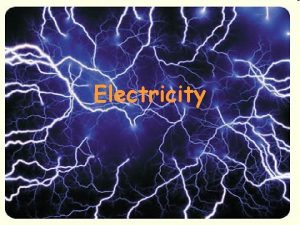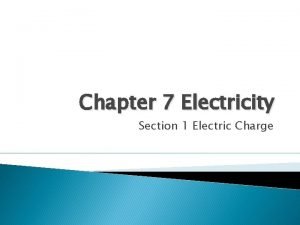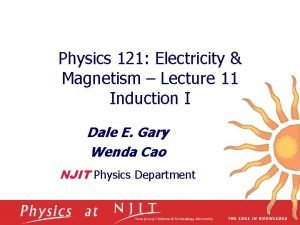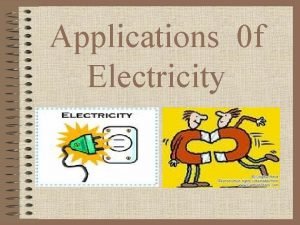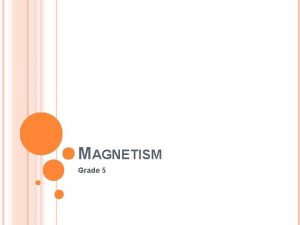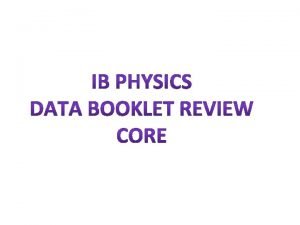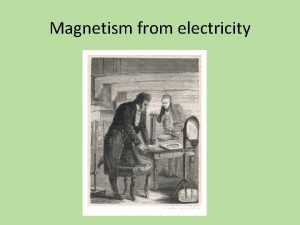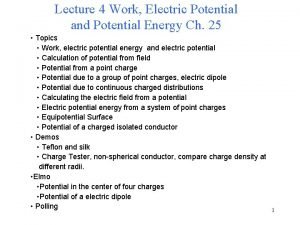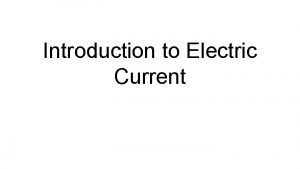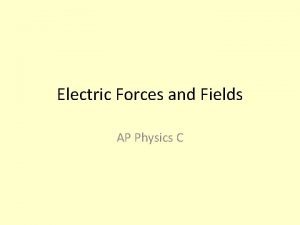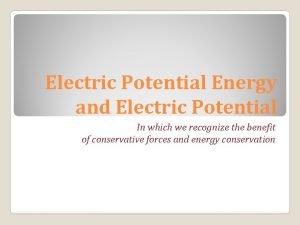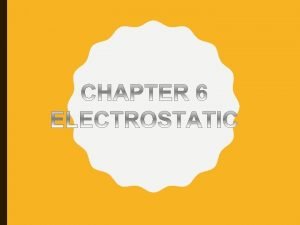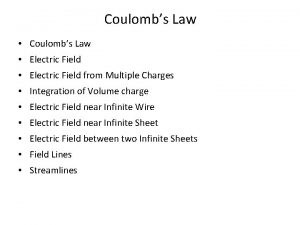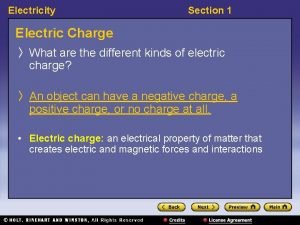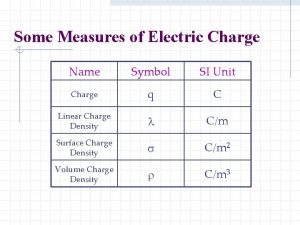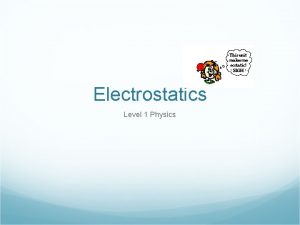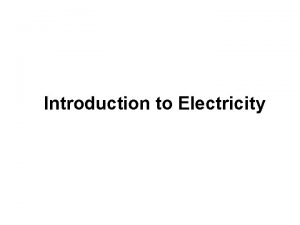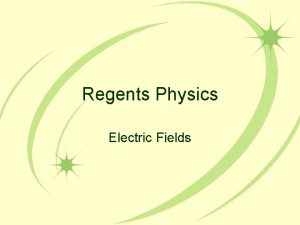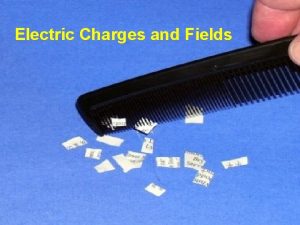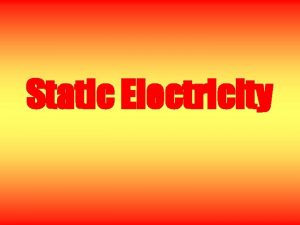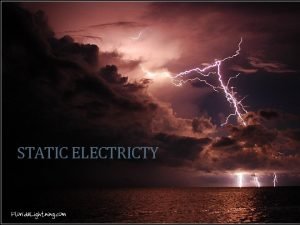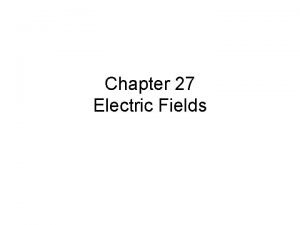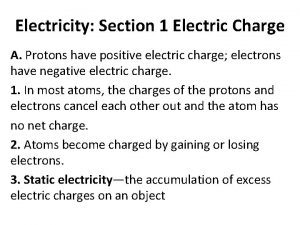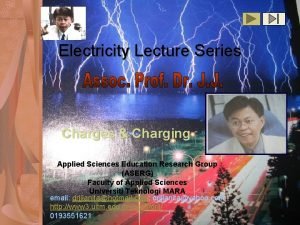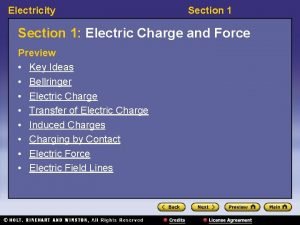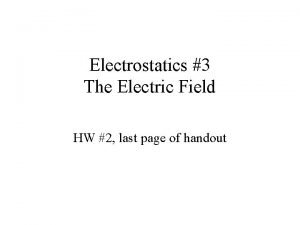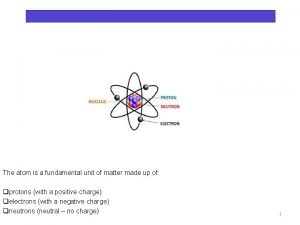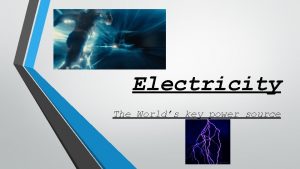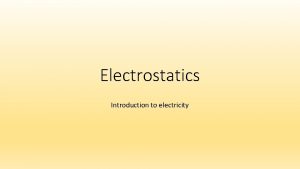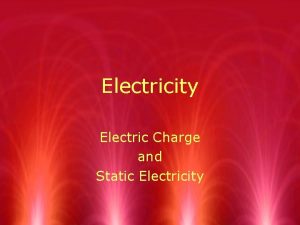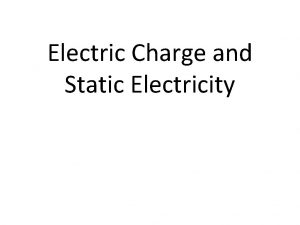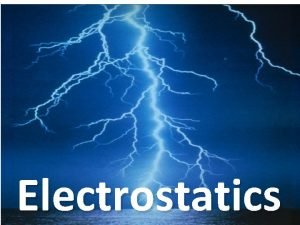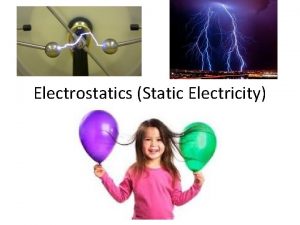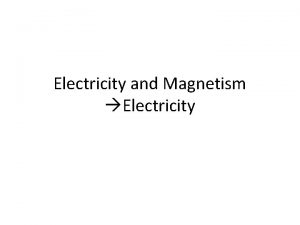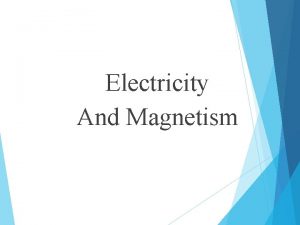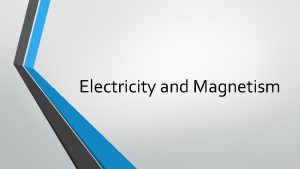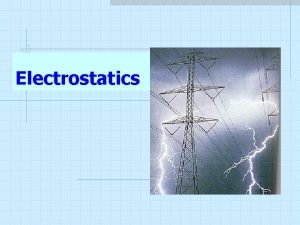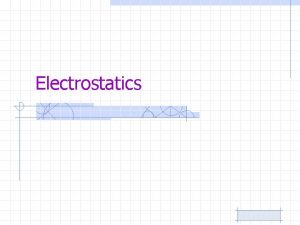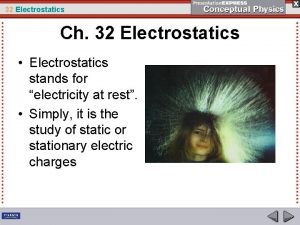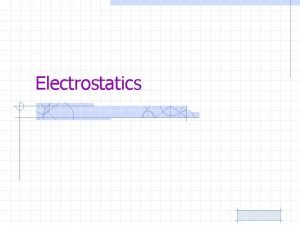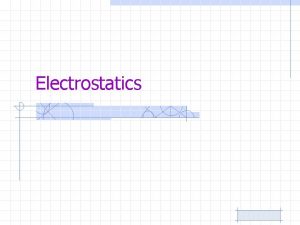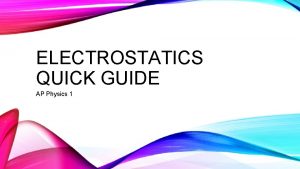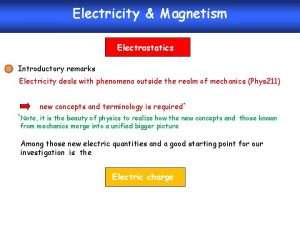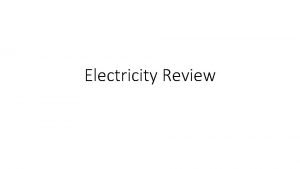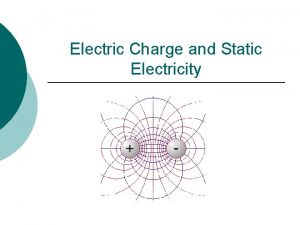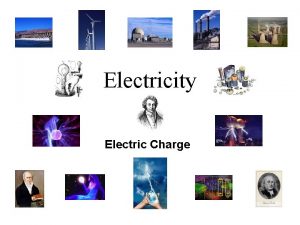Lecture 4 Electricity Magnetism Electrostatics a Electric Charge


















































- Slides: 50

Lecture 4 – Electricity & Magnetism (Electrostatics) a. Electric Charge, Electric Field & Gauss’ Law Copyright © 2009 Pearson Education, Inc.

Chapter 21 Electric Charge and Electric Field Copyright © 2009 Pearson Education, Inc.

Units of Chapter 21 • Static Electricity; Electric Charge and Its Conservation • Electric Charge in the Atom • Insulators and Conductors • Induced Charge; the Electroscope • Coulomb’s Law • The Electric Field • Field Lines Copyright © 2009 Pearson Education, Inc.

21 -1 Static Electricity; Electric Charge and Its Conservation Objects can be charged by rubbing Copyright © 2009 Pearson Education, Inc.

21 -1 Static Electricity; Electric Charge and Its Conservation Charge comes in two types, positive and negative; like charges repel and opposite charges attract. Copyright © 2009 Pearson Education, Inc.

21 -1 Static Electricity; Electric Charge and Its Conservation Electric charge is conserved – the arithmetic sum of the total charge cannot change in any interaction. Copyright © 2009 Pearson Education, Inc.

21 -2 Electric Charge in the Atom: Nucleus (small, massive, positive charge) Electron cloud (large, very low density, negative charge) Copyright © 2009 Pearson Education, Inc.

21 -2 Electric Charge in the Atom Polar molecule: neutral overall, but charge not evenly distributed Copyright © 2009 Pearson Education, Inc.

21 -3 Insulators and Conductors Conductor: Insulator: Charge flows freely Almost no charge flows Metals Most other materials Some materials are semiconductors. Copyright © 2009 Pearson Education, Inc.

21 -4 Induced Charge; the Electroscope Metal objects can be charged by conduction: Copyright © 2009 Pearson Education, Inc.

21 -4 Induced Charge; the Electroscope They can also be charged by induction, either while connected to ground or not: Copyright © 2009 Pearson Education, Inc.

21 -4 Induced Charge; the Electroscope Nonconductors won’t become charged by conduction or induction, but will experience charge separation: Copyright © 2009 Pearson Education, Inc.

21 -4 Induced Charge; the Electroscope The electroscope can be used for detecting charge. Copyright © 2009 Pearson Education, Inc.

21 -4 Induced Charge; the Electroscope The electroscope can be charged either by conduction or by induction. Copyright © 2009 Pearson Education, Inc.

21 -4 Induced Charge; the Electroscope The charged electroscope can then be used to determine the sign of an unknown charge. Copyright © 2009 Pearson Education, Inc.

21 -5 Coulomb’s Law Experiment shows that the electric force between two charges is proportional to the product of the charges and inversely proportional to the distance between them. Copyright © 2009 Pearson Education, Inc.

21 -5 Coulomb’s Law Coulomb’s law: This equation gives the magnitude of the force between two charges. Copyright © 2009 Pearson Education, Inc.

21 -5 Coulomb’s Law The force is along the line connecting the charges, and is attractive if the charges are opposite, and repulsive if they are the same. Copyright © 2009 Pearson Education, Inc.

21 -5 Coulomb’s Law Unit of charge: coulomb, C. The proportionality constant in Coulomb’s law is then: k = 8. 99 x 109 N·m 2/C 2. Charges produced by rubbing are typically around a microcoulomb: 1 μC = 10 -6 C. Copyright © 2009 Pearson Education, Inc.

21 -5 Coulomb’s Law Charge on the electron: e = 1. 602 x 10 -19 C. Electric charge is quantized in units of the electron charge. Copyright © 2009 Pearson Education, Inc.

21 -5 Coulomb’s Law The proportionality constant k can also be written in terms of ε 0, the permittivity of free space: Copyright © 2009 Pearson Education, Inc.

21 -5 Coulomb’s Law Conceptual Example 21 -1: Which charge exerts the greater force? Two positive point charges, Q 1 = 50 μC and Q 2 = 1 μC, are separated by a distance. Which is larger in magnitude, the force that Q 1 exerts on Q 2 or the force that Q 2 exerts on Q 1? Copyright © 2009 Pearson Education, Inc.

21 -5 Coulomb’s Law Example 21 -2: Three charges in a line. Three charged particles are arranged in a line, as shown. Calculate the net electrostatic force on particle 3 (the -4. 0 μC on the right) due to the other two charges. Copyright © 2009 Pearson Education, Inc.

21 -5 Coulomb’s Law Example 21 -3: Electric force using vector components. Calculate the net electrostatic force on charge Q 3 shown in the figure due to the charges Q 1 and Q 2. Copyright © 2009 Pearson Education, Inc.

21 -6 The Electric Field The electric field is defined as the force on a small charge, divided by the magnitude of the charge: Copyright © 2009 Pearson Education, Inc.

21 -6 The Electric Field An electric field surrounds every charge. Copyright © 2009 Pearson Education, Inc.

21 -6 The Electric Field For a point charge: Copyright © 2009 Pearson Education, Inc.

21 -6 The Electric Field Force on a point charge in an electric field: Copyright © 2009 Pearson Education, Inc.

21 -6 The Electric Field Example 21 -6: Electric field of a single point charge. Calculate the magnitude and direction of the electric field at a point P which is 30 cm to the right of a point charge Q = -3. 0 x 10 -6 C. Copyright © 2009 Pearson Education, Inc.

21 -6 The Electric Field Example 21 -7: E at a point between two charges. Two point charges are separated by a distance of 10. 0 cm. One has a charge of -25 μC and the other +50 μC. (a) Determine the direction and magnitude of the electric field at a point P between the two charges that is 2. 0 cm from the negative charge. (b) If an electron (mass = 9. 11 x 10 -31 kg) is placed at rest at P and then released, what will be its initial acceleration (direction and magnitude)? Copyright © 2009 Pearson Education, Inc.

21 -6 The Electric Field Example 21 -8: above two point charges. Calculate the total electric field (a) at point A and (b) at point B in the figure due to both charges, Q 1 and Q 2. Copyright © 2009 Pearson Education, Inc.

21 -6 The Electric Field Problem solving in electrostatics: electric forces and electric fields 1. Draw a diagram; show all charges, with signs, and electric fields and forces with directions. 2. Calculate forces using Coulomb’s law. 3. Add forces vectorially to get result. 4. Check your answer! Copyright © 2009 Pearson Education, Inc.

21 -8 Field Lines The electric field can be represented by field lines. These lines start on a positive charge and end on a negative charge. Copyright © 2009 Pearson Education, Inc.

21 -8 Field Lines The number of field lines starting (ending) on a positive (negative) charge is proportional to the magnitude of the charge. The electric field is stronger where the field lines are closer together. Copyright © 2009 Pearson Education, Inc.

21 -8 Field Lines Electric dipole: two equal charges, opposite in sign: Copyright © 2009 Pearson Education, Inc.

21 -8 Field Lines The electric field between two closely spaced, oppositely charged parallel plates is constant. Copyright © 2009 Pearson Education, Inc.

21 -8 Field Lines Summary of field lines: 1. Field lines indicate the direction of the field; the field is tangent to the line. 2. The magnitude of the field is proportional to the density of the lines. 3. Field lines start on positive charges and end on negative charges; the number is proportional to the magnitude of the charge. Copyright © 2009 Pearson Education, Inc.

Summary of Chapter 21 • Two kinds of electric charge – positive and negative. • Charge is conserved. • Charge on electron: e = 1. 602 x 10 -19 C. • Conductors: electrons free to move. • Insulators: nonconductors. Copyright © 2009 Pearson Education, Inc.

Summary of Chapter 21 • Charge is quantized in units of e. • Objects can be charged by conduction or induction. • Coulomb’s law: • Electric field is force per unit charge: Copyright © 2009 Pearson Education, Inc.

Summary of Chapter 21 • Electric field of a point charge: • Electric field can be represented by electric field lines. Copyright © 2009 Pearson Education, Inc.

Chapter 22 Gauss’s Law Copyright © 2009 Pearson Education, Inc.

Units of Chapter 22 • Electric Flux • Gauss’s Law Copyright © 2009 Pearson Education, Inc.

22 -1 Electric Flux Electric flux: Electric flux through an area is proportional to the total number of field lines crossing the area. Copyright © 2009 Pearson Education, Inc.

22 -1 Electric Flux Example 22 -1: Electric flux. Calculate the electric flux through the rectangle shown. The rectangle is 10 cm by 20 cm, the electric field is uniform at 200 N/C, and the angle θ is 30°. Copyright © 2009 Pearson Education, Inc.

22 -1 Electric Flux through a closed surface: Copyright © 2009 Pearson Education, Inc.

22 -2 Gauss’s Law The net number of field lines through the surface is proportional to the charge enclosed, and also to the flux, giving Gauss’s law: This can be used to find the electric field in situations with a high degree of symmetry. Copyright © 2009 Pearson Education, Inc.

22 -2 Gauss’s Law For a point charge, Therefore, Solving for E gives the result we expect from Coulomb’s law: Copyright © 2009 Pearson Education, Inc.

22 -2 Gauss’s Law Using Coulomb’s law to evaluate the integral of the field of a point charge over the surface of a sphere surrounding the charge gives: Looking at the arbitrarily shaped surface A 2, we see that the same flux passes through it as passes through A 1. Therefore, this result should be valid for any closed surface. Copyright © 2009 Pearson Education, Inc.

22 -2 Gauss’s Law Finally, if a gaussian surface encloses several point charges, the superposition principle shows that: Therefore, Gauss’s law is valid for any charge distribution. Note, however, that it only refers to the field due to charges within the gaussian surface – charges outside the surface will also create fields. Copyright © 2009 Pearson Education, Inc.

Summary of Chapter 22 • Electric flux: • Gauss’s law can be used to calculate the field in situations with a high degree of symmetry. • Gauss’s law applies in all situations, and therefore is more general than Coulomb’s law. Copyright © 2009 Pearson Education, Inc.
 Electricity and magnetism lecture notes
Electricity and magnetism lecture notes Electricity section 1 electric charge
Electricity section 1 electric charge Electricity section 1 electric charge
Electricity section 1 electric charge Chapter 6 electricity section 1 electric charge answers
Chapter 6 electricity section 1 electric charge answers Difference between charge and electric charge
Difference between charge and electric charge Electrons flowing
Electrons flowing Chapter 21 electric charge and electric field
Chapter 21 electric charge and electric field Chapter 21 electric charge and electric field
Chapter 21 electric charge and electric field Chapter 16 electric charge and electric field
Chapter 16 electric charge and electric field Dc o/d per item charge
Dc o/d per item charge Electricity and magnetism
Electricity and magnetism Sph3u electricity and magnetism
Sph3u electricity and magnetism Electric fuse and circuit breaker graphic organizer
Electric fuse and circuit breaker graphic organizer 4 forces of nature
4 forces of nature Magnetism vocabulary
Magnetism vocabulary Magnetic susceptibility formula
Magnetic susceptibility formula Relationship between electricity and magnetism
Relationship between electricity and magnetism Ampere
Ampere Ib physics chapter 5
Ib physics chapter 5 Grade 5 electricity and magnetism
Grade 5 electricity and magnetism Electricity and magnetism
Electricity and magnetism Electricity jeopardy
Electricity jeopardy Electricity and magnetism
Electricity and magnetism Static electricity and current electricity
Static electricity and current electricity Electricity n
Electricity n 01:640:244 lecture notes - lecture 15: plat, idah, farad
01:640:244 lecture notes - lecture 15: plat, idah, farad Electric potential lecture
Electric potential lecture Physics 102
Physics 102 Continuous flow of electric charges
Continuous flow of electric charges Electric field of line charge
Electric field of line charge Sheet of charge electric field
Sheet of charge electric field Electric potential energy
Electric potential energy Electric charge
Electric charge Electric force units
Electric force units Sheet of charge electric field
Sheet of charge electric field Section 1 electric charge crossword puzzle answers
Section 1 electric charge crossword puzzle answers Surface charge density symbol
Surface charge density symbol Electrostatics conceptual questions
Electrostatics conceptual questions Electric charge symbol
Electric charge symbol Electric field lines about a point charge extend
Electric field lines about a point charge extend What is amber effect
What is amber effect Static electricity.
Static electricity. Charging by conduction
Charging by conduction Electric field equation
Electric field equation Section 1 electric charge
Section 1 electric charge Charging by contact
Charging by contact Section 1 electric charge
Section 1 electric charge Force on charge in electric field
Force on charge in electric field Electric charge
Electric charge What is electric charge measured in
What is electric charge measured in Unidirectional flow of electric charge
Unidirectional flow of electric charge

